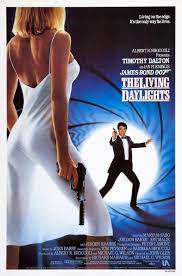
James Bond (Timothy Dalton) is trying to help KGB General Georgi Koskov (Jeroen Krabbe) defect. The scam involves shooting a KGB sniper in Bratislava, Czechoslovakia, but Bond smells a rat when the sniper he is to kill is a female cellist named Kara Milovy (Maryam d’Abo) who doesn’t know one end of a sniper rifle from the other. He purposely misses the kill shot. They end up sending Koskov to the West in a scouring pig inside the Trans-Siberian Pipeline. Koskov reveals to MI-6 that the old pre-Détante policy of Smiert Spionam or “Death to Spies” has been revived by General Pushkin (John Rhys-Davies), the new head of the KGB. In a bold attack, Koskov is abducted from the MI-6 safe house and is assumed to be back in Russia. Bond is sent to Tangier to track down Pushkin and kill him.
But he first goes to Bratislava to track down the cellist, Kara, where he discovers that the entire defection was staged and Kara is merely Koskov’s girlfriend. He convinces the girl that he is a friend of Koskov and she comes with him to Vienna to meet with him. They escape from the KGB and cross the border, skiing down a snowy slope in a cello case. Don’t ask. Meanwhile, Pushkin is meeting with a half-crazy arms dealer named Whitaker (Joe Don Baker) in Tangier to cancel a misguided KGB arms deal.
With Kara in Vienna, he meets with MI-6 agent Saunders (Thomas Wheatley), who is killed by Koskov’s creepy henchman Necros (Andreas Wisniewski), who had taken Koskov from the safe house. Bond and Kira leave for Tangier, where Bond confronts Pushkin, who reveals that Koskov is wanted by the Soviets for embezzlement of weapons funds. Bond decides not to kill Pushkin after all and they set up a fake assassination. Kara tracks down Koskov, who convinces her that Bond is a KGB agent. Bond is captured and taken with Koskov, Necros, and Kara to a Soviet airbase in Afghanistan, where Koskov reveals himself as an ass-hole and locks up Kara with Bond. They escape and help Afghan prisoner Kamran Shah (Art Malik), who is the leader of the local Mujahideen rebels. Koskov is using Soviet weapons funds to finance opium smuggling.
With the help of the Mujahideen, Bond plants a bomb in the cargo plane full of opium but is pinned down in the plane with Kara and has to take off in the midst of a battle between the Soviets and the Mujahideen. But the assassin Necros also boards the plane and he and Bond battle to the death, hanging out of the open cargo-door as the bomb ticks down. Bond throws Necros to his death and deactivates the bomb, but when he sees the mujahideen about to be overrun by the Russians, he drops the bomb on a bridge, stopping the Soviet advance and saving the rebels.
The plane runs out of fuel and crashes as Bond and Kara drive a jeep out the back just in time. Bond returns to Tangier to confront, battle, and kill Whitaker, and Pushkin sends Koskov to his doom. Later, Kara is the solo cellist in the Vienna orchestra. Kamran Shah and his Mujahideen crash the reception, where they meet Bond’s sort-of ally General Gogol (Walter Gotell), and Bond surprises Kara in her dressing room.
The film was directed by John Glen, loosely based on the Ian Fleming story. It was the first of two starring Timothy Dalton, the first to feature Caroline Bliss as the new Moneypenny, and the first to be produced by Albert Broccoli, his stepson Michael Q. Wilson, and his daughter Barbara Broccoli. It received mixed reviews but was a success with audiences. After Roger Moore left, the studio looked at New Zealander Sam Neill, Irishman Pierce Brosnan, and Welshman Timothy Dalton. MGM wanted Mel Gibson but Broccoli refused. They chose Pierce Brosnan, whose TV series Remington Steele was done, but the Bond publicity revived interest in the series and they forced Brosnan to stay another year. But when Dalton was chosen, the interest in Remington Steele cooled down and they only produced five more episodes. The day before shooting was to begin, Roger Moore said he’d like to come back, but Broccoli said no.
I’ve always liked Timothy Dalton as Bond, who seemed to me very much like the character in the books and reminded the public of Sean Connery. Connery himself thought Dalton was a good choice. The pre-title sequence on the Rock of Gibraltar was a great set-up for the new Bond, who was put through his paces as an action hero, partly to contrast with the sedate and nonchalant Roger Moore. Dalton himself rode the top of the Land Rover careening down the mountain road. Maryam d’Abo was a new intelligent and bold love-interest for Bond, also very welcome. This was the last film to be scored by John Barry. He appeared on screen as an orchestra leader. The cool theme song was sung by Norwegian group A-ha. The film has continued to be popular.
The Ferris wheel is the same one that was in The Third Man (1949). Director John Glen’s first job in the movies was in the sound department of that film. The film was released on the 25th anniversary of the Bond films. Dalton was nineteen years younger than Roger Moore. An interesting historical note: The Soviet-made arms used by the Mujahideen rebellion were bought through Israel by the U.S. and smuggled into Afghanistan, labelled as Russian instead of American, and the Mujahideen had no idea that the U.S. had helped them gain independence and they later fought the Americans as fiercely as the Russians. Even when governments do something right, they do it wrong.
